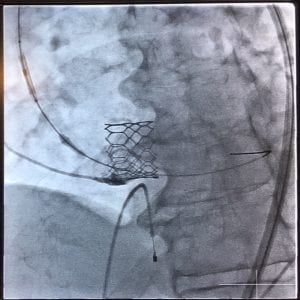
One of the most life changing procedures I do is a minimally invasive approach to inserting a new aortic valve in patients – TAVI. As a doctor it is immensely satisfying because (1) the patient feels better immediately (2) it significantly extends that patients life and most importantly significantly improves their quality of life and (3) it is the only treatment available for certain patients. The procedure can now be completed within 40 minutes with the patient awake and often discharged home within 72 hours.
The aortic valve is a heart valve – valves can be likened to doors. They open to allow blood to flow in one direction through the heart and close to prevent blood from going backwards. The aortic valve opens to let blood flow from the heart to the rest of the body. It opens and closes with every single heartbeat and, with time, it can become stiff. If the valve becomes stiff it doesn’t open properly and the heart has to work harder to push the same amount of blood around the body. This is aortic stenosis and patients can feel short of breath, chest pain, dizziness or even blackout when this is severe.
Aortic stenosis can be treated with open-heart surgery, when the valve can be replaced. But in certain patients open-heart surgery is too high risk and associated with a very prolonged recovery period. TAVI was introduced as a minimally invasive treatment to help these patients. Prior to TAVI these patients had no treatment options and would be left to suffer from the debilitating effect of a gradually ever-narrowing heart valve, recurrent hospital admissions, heart failure and death.
Often patients have resigned themselves to limiting their activity and coping with their symptoms of chest tightness or shortness of breath because they assume that there are no treatment options available, assume that they are too old to be treated or they assume that any treatment will be too risky. However, in reality the opposite is true – the risk of doing nothing is very high and far outweighs the risk of a TAVI in most patients. By the time a person has developed symptoms from aortic stenosis their survival is lower than most cancers, with a 50% chance of death or hospitalisation within a year. Yet their survival reverts to normal when the valve is treated. The risk of the TAVI procedure is now less than 5% of significant complication – so doing nothing is actually, usually the higher risk option!
TAVI therefore provides a life changing intervention, at a relatively low risk, to patients that have often resigned themselves to a limited quality of life. Its one treatment that literally adds years to life and most importantly good quality of life to those years
The replacement valve can be inserted in a minimally invasive manner avoiding the need for open heart surgery.
The most common access sites for this procedure are through the artery at the top of the leg (femoral artery) or via the artery at the top of the shoulder (subclavian artery).
Not all patients are suitable for TAVI and your clinician may request several tests to determine your suitability. These may include lung function tests, CT scans and a scan of the arteries in your neck.
The procedure can be done under sedation (local anaesthetic) and usually takes approximately one hour.
There is an approximately 1 in 20 risks (5%) of a serious complication developing during the procedure. Complications could include a stroke (1-3% chance), vascular complication, death, and the need for urgent open heart surgery.
The recovery time from the procedure varies but the majority of patients will be home after 48-72 hours.
